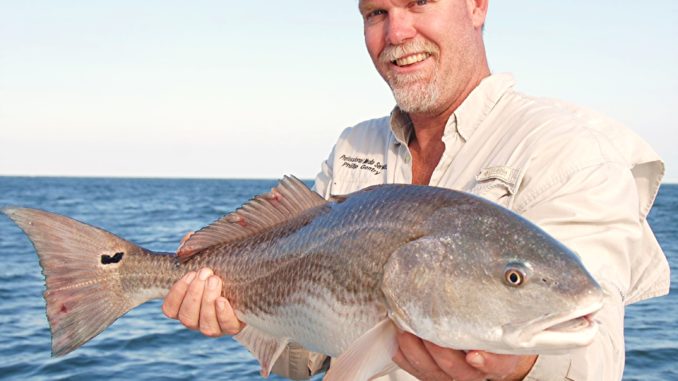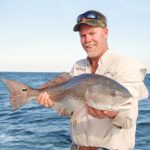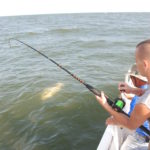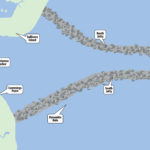
Spawning or feeding? Bull reds are big news in Charleston Harbor in August and September.
Rick Hiott of Charleston has been guiding trips for redfish for years, and he looks forward to the late summer and early fall season when adult redfish, bull reds, converge on the large marine estuary commonly known as Charleston Harbor.
Whether the bulls invade the area because of their own spawning urges or just to stock up on groceries is a matter of debate among anglers and biologists. For whatever reason, a piece of chunked blue crab, cut baitfish or a whole live baitfish offered on the bottom near drop-offs that feature some type of hard structure will quickly have anglers running for their rods.
Catching adult redfish in and around Charleston Harbor is an ongoing summer event, but it really heats up late in the summer and lasts until the fall mullet run when anglers from all over come out to run with the bulls.
As a fishing site, Charleston Harbor is a large area, measuring some eight to 10 miles long and nearly three miles wide and punctuated by a parallel set of rock jetties that open into the ocean. Hiott can speak for the “magnetism” of this area. While the Grillage, Dynamite Hole, the jetties, or Lighthouse Inlet could hardly be considered secret fishing spots, there is something to be said for knowing and understanding how these fish relate to these types of structure as well as the main shipping channel itself.
“A lot of people fish these spots, but to be consistent, you have to look for some kind of deviation in the larger area, a large rock outcropping, a sudden drop-off, or a washed out area. You can’t just motor up to the jetties, throw out an anchor and expect to catch fish.”
“Bull reds love to hang along the edge of channels or anywhere there could be some structure in the harbor,” said Hiott, “from the end of the jetties all the way back underneath the Cooper River bridge, but you’ve got to be on the bottom. You’re fishing probably 30- to sometimes 50-foot deep. Use a 4- to 5-foot leader of 80-pound monofilament and an 8/0 circle hook.”
Tide and current also plays a big factor in getting the big boys to come out and play. Moving water means food to all fish, but there are variables within the tides that also come into play. Hiott doesn’t have a favorite, either incoming or outgoing, but he’s not a big fan of extremes when it comes to tides.
“Long as the water is moving they’ll bite,” he said, “but I don’t like to fish during the full moon or new moon tides because it gets the water moving too fast. It’s too hard to keep your bait on the bottom, and I think there’s a point where they just aren’t going to fight the current to eat.”
Hiott offers that if fishing full- or new-moon tides is unavoidable, it’s better to fish right after the tide changes, either high or low, than to try to fish in the middle.
“I’ve found they’ll either bite right before the tide changes or right after, but seldom both,” he said.
As for setting up on a location, a fair amount of Kentucky windage is required when positioning the boat. You motor over an area, find that sweet spot where fish will be holding, then you motor upcurrent far enough to allow proper scope for a good anchor set, plus enough distance to cast lines out so they’ll lay correctly behind the boat.
“You’re anchored up-current from your target,” he said. “Fishing on the bottom, you’ve got to be on the bottom. I’ll use up to eight ounces of lead so I can keep my bait on the bottom.”
“I also only use one anchor, and that’s only from the bow of the boat, never two,” said Hiott. “Once the tide kicks in, you won’t swing too bad unless there happens to be a bad cross wind. If you put an anchor out from the stern, you’ll lose fish in it and you’ll hang your lines in it. Take your time and get set in the right spot, even if it takes you a couple of tries to get it just right. It’ll pay off later.”
Fishing in and around this type of structure requires pretty stout equipment, both to withstand the tides and handle hard charging redfish that reach upwards to 50 pounds.
“My minimum test line starts at 30 pounds,” said Hiott, who uses Pflueger Contender baitcasting reels combined with Ugly Stik Custom rods in medium heavy action.
Hiott deploys up to four rods out of the stern of his boat, held securely in rod holders. Invariably, the rising current will move the baits directly behind the boat, so Hiott prefers to place one bait closer than the other on each side of the boat.
His choice of baits may vary through the summer into fall, but only slightly. He prefers to use chunked blue crab in the summer but by the end of August and into the fall, he’ll use almost entirely finfish for bait.
“Almost anything works, menhaden, mullet, croaker, spot, whiting, bluefish. Just about any small trash fish,” he said. I like cut, but I’ll give them a choice, you can use two lines with cut and two with live, then let them pick. Some days you’re better off with cut than you are with live.
“If you’re in a good spot but the sharks won’t leave you alone, you can use blue crab. Take the top off and quarter him up. That puts a good smell in the water for the reds, and the sharks will pretty much leave it alone, except for the bonnetheads.”
On the scientific side of the equation, surprisingly little is known about the “why” behind seasonal movements of adult red drum in the harbor. Biologists with SCDNR use several methods to piece together the puzzle, in Charleston and other prime estuaries along the coast, in an effort to preserve one of the state’s most popular gamefish reserves. According to Bill Roumillat, a marine biologist based at the SCDNR’s Ft Johnson location, studying large adult redfish is a more difficult task than the juveniles.
“We’ve been tagging red drum since the mid 80s,” said Roumillat. “We know a little about the movements of the adults but not like the juveniles. We’re still are up in the air about what the adults are doing and we are tagging each one we can with special tags. It’s so hard to catch the adults in numbers, certainly not numbers like we see the juveniles inshore.”
While individually fishing out adult drum for scientific study may seem feasible, Roumillat and SCDNR biologists have found that using long lines, a commercial application frequently used by offshore sword fishermen has been favored. The setup is essentially a huge trotline stretched between markers and placed in the harbor.
“This long-line work seems to be very promising because we’re able to catch sometimes as many as 100 fish in a set,” said Roumillat. “Most of the time, they catch nothing because they’re in the wrong part of the world. The fish have moved from one area to the other. Still, we’re gathering some really critical biological information from all the data when we do find them.”
Another elusive piece of the adult drum puzzle is where they go to overwinter. Biologists typically use satellite tags to record long term movements of valuable fish stocks, but cost, and funding, for these type studies is nearly prohibitive.
“One of the things we are hoping to do is outfit some adult fish with satellite tags when these folks are catching them early in the fall,” said Roumillat. “The tags cost about $5 grand apiece, they’re what’s known as pop-up tags. After 60 days being attached to the fish, they pop up from wherever the fish happens to be and radio data to satellites to give us some idea of its movements and depths during that time period.”
Both anglers and biologists alike have a keen interest in the winter whereabouts of adult drum. Little is known except when large schools suddenly materialize offshore during a feeding frenzy, then disappear just as quickly.
“We have ancillary information from divers reporting a whole school of red drum swimming by an artificial reef in the wintertime,” said Roumillat. “They happen to be around that artificial reef on that particular day but we don’t know what they do otherwise.”
DESTINATION INFORMATION
WHEN TO GO — Adult redfish that measure longer than 30 inches migrate into Charleston Harbor when water temperatures reach the 70-degree mark, usually in early May. The peak fishing, however, is August and September.
HOW TO GET THERE — Charleston is most-easily access from most of South Carolina via I-26 from the west, US 52 from the north and US 17 from other points on the coast. Three of the most popular public boat-access areas that serve the Charleston Harbor area Remley’s Point and Shem Creek in Mount Pleasant, and Wappoo Cut in West Ashley. Visit www.dnr.sc.gov/mlands/boatramp/ for exact locations.
TECHNIQUES/TACKLE — Depending on the tide, anchor close to bends, holes and washes around the jetties or along the drop- off of the main channel in Charleston Harbor. Fish Carolina-rigged baits around the base of the rocks where redfish hang out looking for the current to sweep food past. Best baits are whole or cut menhaden, mullet or half of a blue crab with the shell removed. If you set up on a spot and don’t get a bite in 30 minutes, go somewhere else. During the summer, sharks and rays frequent the same areas and feed on the same baits, so expect to weed through a number of them to get to the redfish.
GUIDES/FISHING INFO — Capt. Rick Hiott, Inshore Fishing Charters, 843-554-9386, www.reelfishhead.com; Haddrell’s Point Tackle, Mount Pleasant, 843-881-3644; The Charleston Angler, 654 St. Andrews Blvd., Charleston, 843-571-3899; SC Marine Game Fish Tagging Program, 843-953-9363, www.dnr.sc.gov/marine/tagfish. See also Guides and Charters in Classifieds.
ACCOMMODATIONS — Best Western Patriots Point, 259 McGrath Darby Blvd., Mount Pleasant, 843-971-7070; Town and Country Inn & Conference Center, 2008 Savannah Hwy, Charleston, 800-334-6660; La Quinta Inn & Suites, Charleston Riverview, 11 Ashley Pointe Dr., Charleston, 843-556-5200.
MAPS — Maps Unique, 910-458-9923, www.mapsunique.com.
Sealake Fishing Guides, 800-411-0185, www.thegoodspots.com.








Be the first to comment